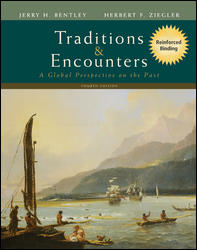 
Traditions and Encounters, 4th Edition (Bentley)Chapter 5:
EARLY SOCIETIES IN EAST ASIAChapter Outline- Political organization in early China
- Early agricultural society and the Xia dynasty
- The Yellow River
- Water source at high plateau of Tibet
- Loess soil carried by the river's water, hence "yellow"
- "China's Sorrow"--extensive flooding
- Loess provided rich soil, soft and easy to work
- Neolithic societies after 5000 B.C.E.
- Yangshao society, 5000-3000 B.C.E.
- Excavations at Banpo village: fine pottery, bone tools
- The Xia dynasty
- Archeological discovery of the Xia is still in its early stages
- Established about 2200 B.C.E.
- Legendary King Yu, the dynasty founder, a hero of flood control
- Erlitou: possibly the capital city of the Xia
- The Shang dynasty: 1766-1122 B.C.E.
- Arose in the southern and eastern areas of the Xia realm
- Many written records and material remains discovered
- Bronze metallurgy, monopolized by ruling elite
- Horses and chariots traveled with Indo-European migrants to China
- Agricultural surpluses supported large troops
- A vast network of walled towns
- The Shang capital moved six times
- Lavish tombs of Shang kings with thousands of objects
- Other states besides Shang, for example, Sanxingdui
- The Zhou dynasty: 1122-256 B.C.E.
- Zhou gradually eclipsed Shang
- Mandate of heaven, the right to rule
- The Zhou needed to justify the overthrow
- Ruler as "the son of heaven"
- Mandate of heaven only given to virtuous rulers
- Political organization: decentralized administration
- Used princes and relatives to rule regions
- Consequence: weak central government and rise of regional powers
- Iron metallurgy spread through China in first millennium B.C.E.
- The fall of the Zhou
- Nomadic invasion sacked Zhou capital in 711 B.C.E.
- Territorial princes became more independent
- The Warring States (403-221 B.C.E.)
- The last king of the Zhou abdicated his position in 256 B.C.E.
- Society and family in ancient China
- The social order
- The ruling elites with their lavish consumption of bronze
- Hereditary aristocrats with extensive landholding
- Administrative and military offices
- Manuals of etiquette
- Free artisans and craftsmen mostly worked for elites
- Merchants and trade were important
- Trade networks linked China with west and south
- Oar-propelled boats traded with Korea and offshore islands
- Peasants, the majority of population
- Landless peasants provided labor
- Lived in small subterranean houses
- Women's work: wine making, weaving, silkworm raising
- Wood, bone, stone tools before iron was spread in the sixth century B.C.E.
- Slaves, mostly war prisoners
- Family and patriarchy
- Early dynasties ruled through family and kinship groups
- Veneration of ancestors
- Belief in ancestors' presence and their continuing influence
- Burial of material goods with the dead
- Offering sacrifices at the graves
- Family heads presided over rites of honoring ancestors' spirits
- Patriarchal society evolved out of matrilineal one
- The rise of large states brought focus on men's contribution
- After the Shang, females devalued
- Early Chinese writing and cultural development
- The secular cultural tradition
- Absence of organized religion and priestly class
- Believed in the impersonal heavenly power--tian
- Oracle bones used by fortune-tellers
- Inscribed question, subjected to heat, read cracks
- Discovery of the "dragon bones" in 1890s
- Early Chinese writing, from pictograph to ideograph
- More than two thousand characters identified on oracle bones
- Modern Chinese writing is direct descendant of Shang writing
- Thought and literature
- Zhou literature--many kinds of books
- The Book of Change, a manual of diviners
- The Book of History, the history of the Zhou
- The Book of Rites, the rules of etiquette and rituals for aristocrats
- The Book of Songs, a collection of verses--most notable work
- Most Zhou writings have perished
- Ancient China and the larger world
- Chinese cultivators and nomadic peoples of central Asia
- Nomadic peoples of the steppe lands--herders
- Exchange of products between nomads and Chinese farmers
- Nomads frequently invaded rich agricultural society
- Nomads did not imitate Chinese ways
- Nomads relied on grains and manufactured goods of the Chinese
- The southern expansion of Chinese society
- The Yangzi valley; dependable river; two crops of rice per year
- The indigenous peoples of southern China
- Many were assimilated into Chinese agricultural society
- Some were pushed to hills and mountains
- Some migrated to Taiwan, Vietnam, Thailand
- The state of Chu in the central region of Yanzi
- Challenged the Zhou for supremacy
- Adopted Chinese political and social traditions and writing
 |  |
|





